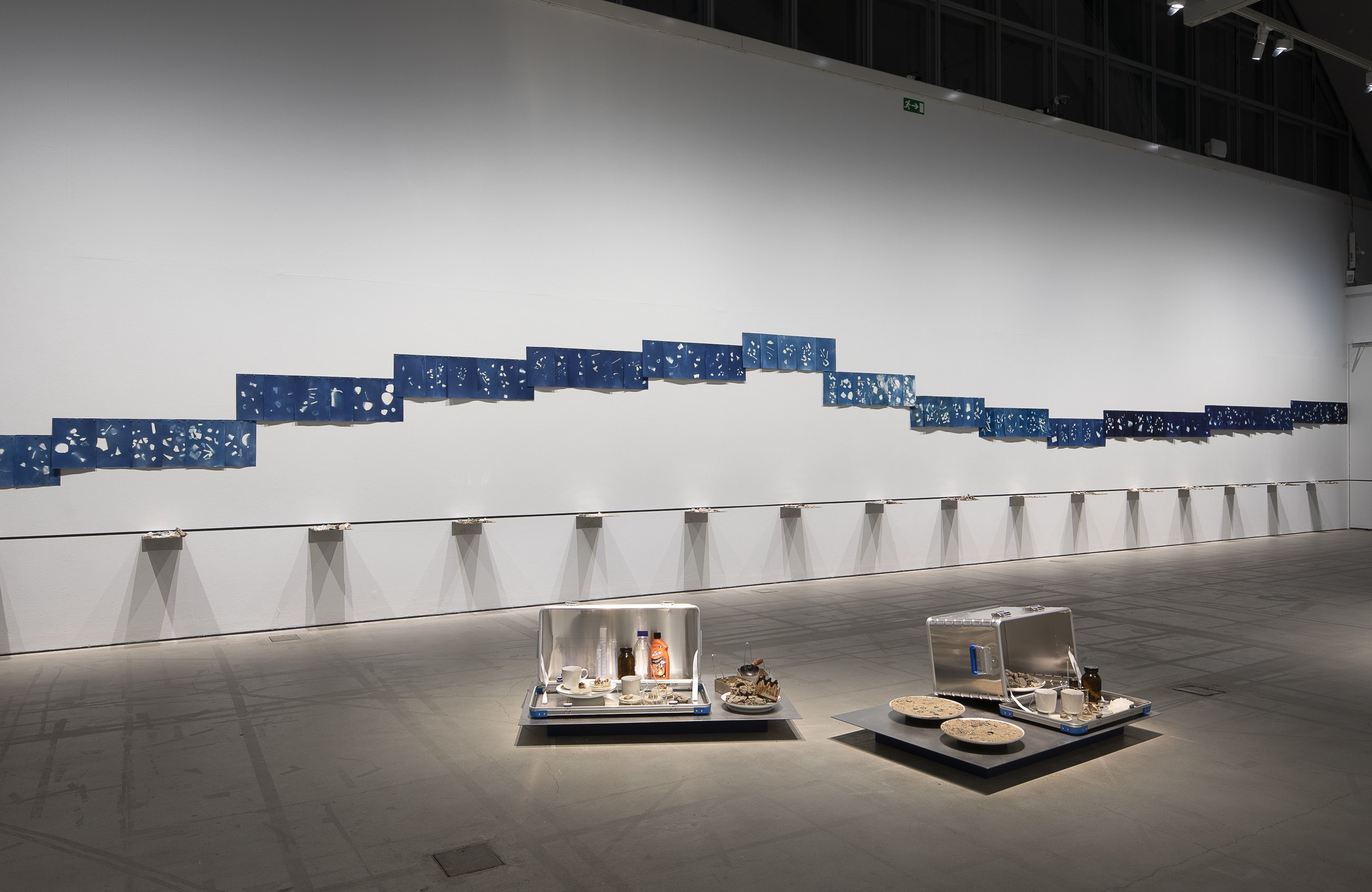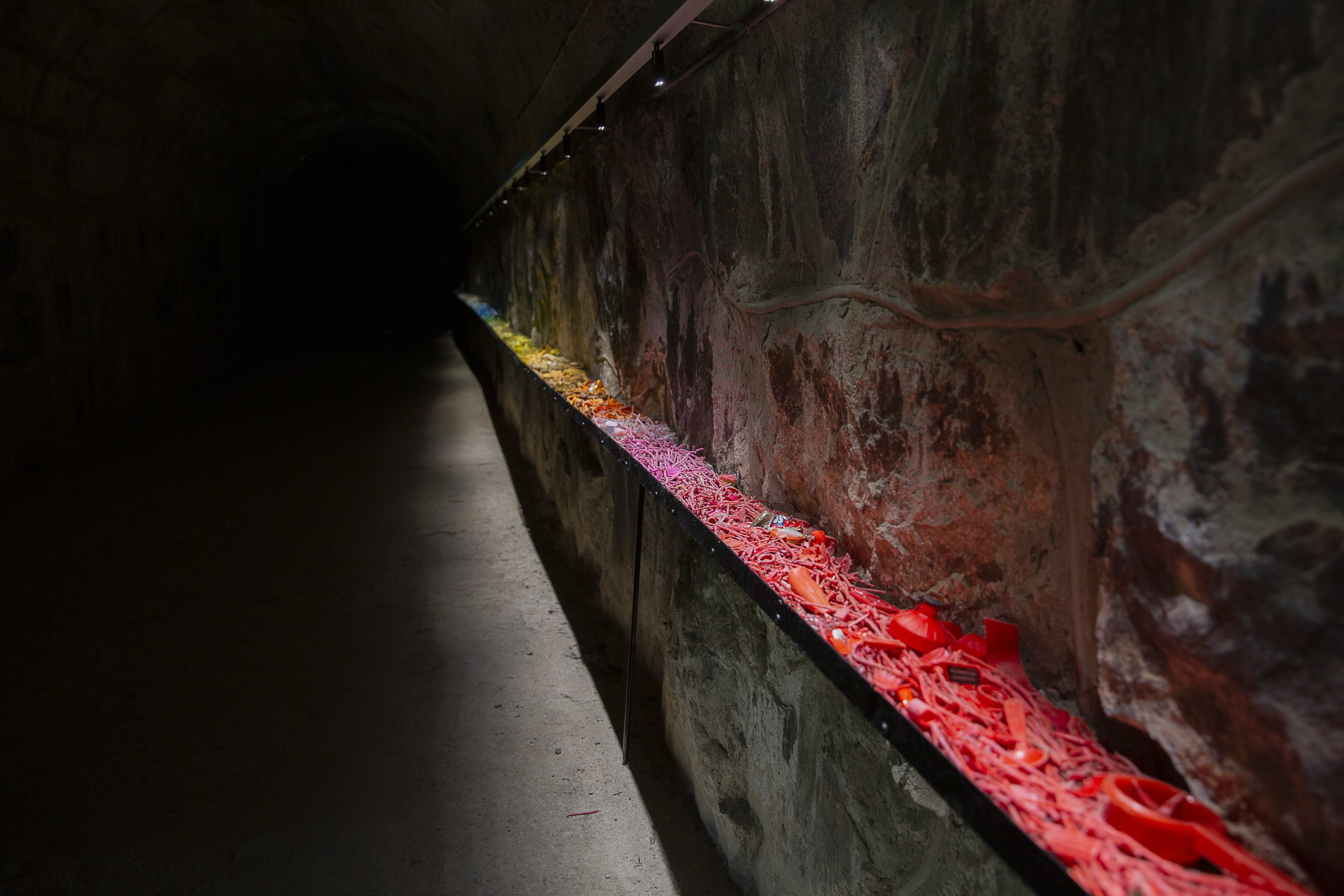Tuula Närhinen is an artist whose practice is committed to exploring environmental issues. Re-adapting methods and instruments derived from natural sciences, she facilitates the transcription of different natural phenomena into visual narratives. The sea provides Närhinen with the subject matter, material and medium for many projects.
From her studio on Harakka Island, she is opportunely located to closely monitor the Baltic Sea. The distance to the mainland is only 100 metres, but to visit her studio, one must cross the sea. Most often the only way to get there is by rowboat – or by walking on the ice in winter. On her way, the artist literally touches the water, which is one of the reasons why her practice is so intimately connected to the complexity and controversial nature of marine life, including the environmental threats caused by anthropogenic waste such as plastic.
Helsinki Biennial 2023 presented two recent installations by Närhinen, one on Vallisaari Island and another at HAM Helsinki Art Museum.
Every time I walk among the seaweed and flotsam, scanning the debris-strewn beach, I am thrilled to discover what has drifted ashore. I find treasures among other people’s rubbish: I pick up trash and put the odd pieces together to make the human footprint visible. Among the garbage washed up on Helsinki’s beaches, I can find junk that dates back perhaps no more than a few years, whereas exploring the Thames foreshore at low tide, every few steps I stumbled on fragments dating back hundreds of years. I am always amazed at how powerfully you can connect with the stories of the city by beachcombing and mudlarking. The shoreline never stays the same. Thanks to liminal places such as the Helsinki archipelago and the Thames foreshore, I have had the chance to discover the magic of margins in visiting the wild, free and resilient edges where the city meets the sea.
The Plastic Horizon (2019) is a result of a desperate cleaning operation. Since 2006, I have gathered plastic debris from Helsinki’s seashores. I felt a strong urge to pick up every scrap and sort them by colour to ‘organize’ the mess. But my attempt was doomed to fail. The deeper I dug into the solid heaps of thickly packed organic and inorganic debris, the more plastic I found – everything from unrecognizable broken fragments to new, intact items. I spent hours combing the shoreline, my hands eagerly picking up every tiny piece and storing them carefully like berries in a bucket. I kept an inventory of all the materials that make up my installation: straws, Q-tips, fishing tackle, bottle caps, toys, pellets, polyurethane foam and pieces of detonator tubing used for underbelly explosives. My archaeological interest notwithstanding, it was the colours that I was primarily after. I went as far as washing off the dirt and dust to fully appreciate their brightness. Unfortunately, I am not the only animal attracted by the allure of debris; countless seabirds, fish and whales keep falling under its spell, only to suffer the fatal consequences of indigested plastic.
Deep Time Deposits: Tidal Impressions of the River Thames (2020) invites audiences to consider the river as a time-machine and a naturally occurring archive of the Anthropocene. Churned by currents, flotsam and jetsam are slowly deposited into the riverbed sediments. During my 34 days of artist-in-residency, I worked in the tradition of the London mudlark, searching the beaches daily to create a portrait of tidal action. At low tide, when the water recedes, long stretches of foreshore are uncovered, exposing odds and sods that emerge from the mud to tell the story of a city. The installation includes cyanotype contact prints, mud chromatograms, pickings of debris and evidence of the material process. Exposed to sun, wind and rain, the light-sensitive iron compounds of the cyanotypes were harnessed to build an atmospheric record of the river’s ‘anthropogenic burden’. Aspects of trade and cultural cargo such as tea-related traditions were addressed by means of paper chromatography, a filtering process that reveals the chemical components of mud. In exhibiting the effects of ebb and flow, the work displays the non-human archival labour of the mud, examining its natural and cultural impacts and setting out to explore the archaeological condition of the Thames foreshore.
Tuula Närhinen

Tuula Närhinen, Deep Time Deposits: Tidal Impressions of the River Thames, 2020. © HAM/Helsinki Biennial/Kirsi Halkola

Tuula Närhinen: The Plastic Horizon, 2019-2023, © HAM/Helsinki Biennial/Sonja Hyytiäinen
Närhinen’s work has featured in solo and group shows internationally since the beginning of her career in the 1990s. Some recent venues include the Finnish Museum of Photography Helsinki (2022); Amos Rex, Helsinki (2022); New Tretyakov Gallery, Moscow (2021); Lands End, Cliff House San Francisco (2021); The Festival of Political Photography, Finnish Museum of Photography Helsinki (2021); Jyväskylä Art Museum, Kunsthalle Turku, and Mikkeli Art Museum Finland (2021); Beaconsfield Gallery Vauxhall, London (2020); Sinebrychoff Art Museum, Helsinki (2020).
In 2021 Närhinen received the Finnish State Prize for the Visual Arts, and in 2019 she was awarded the Below Zero Art Prize by Beaconsfield Gallery Vauxhall in collaboration with the Finnish Institute in London.
Tuula Närhinen
The Plastic Horizon 2019 (Vallisaari) and Deep Time Deposits – Tidal Impressions of the River Thames 2020 (HAM)
The Plastic Horizon: installation (plastic waste drifted ashore in Helsinki)
Deep Time Deposits – Tidal Impressions of the River Thames: installation (cyanotypes on Saunders Waterford paper 300gms, mudlarking finds, steel shelves, 34 tape measures, steel tape, magnets, flight cases, evidence of the material processes)
The Plastic Horizon is shown courtesy of the artist.
Deep Time Deposits: Tidal Impressions of the River Thames, collections of HAM Helsinki Art Museum.